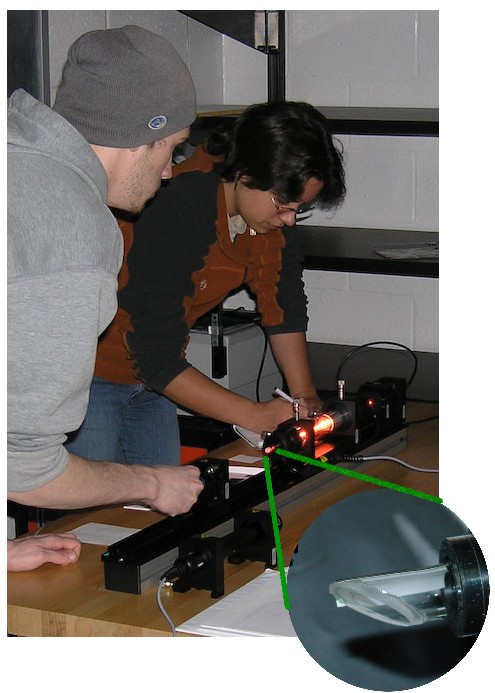Experiment of The Month
Laser Construction
In our new (2007) optics course, students turn a plasma tube into a light amplifier - They turn a lamp into a laser.
Unlike commercial lasers, this laser has an open laser cavity. The placement and alignment of the mirrors that define the cavity

The helium-neon plasma glows because it is a gas discharge, excited by a high voltage source, but it is not yet lasing. In order to amplify light, the two mirrors that define the laser cavity must form a standing light wave pattern between them. The two knobs near Dr. Dushkina's right hand adjust the angle of that mirror so that light hitting it from the left is reflected back along the same path. When this is done, the standing 
In the figure at the right, students have just aligned the mirrors, and the laser has turned on.
Some of the red HeNe light scatters from the mirrors so that now the right mirror shows us a small red dot; the characteristic HeNe color.
At the lower right corner of this picture is an enlarged image of the "Brewster window
The window is angled relative to the laser beam so that light entering the window glass strikes it at an angle called "Brewster's angle."
At Brewster's angle, light whose electric field is perpendicular to the plane of incidence is the only light reflected. This light is said to be "s-polarized: and about 16% of it is reflected at this angle.
The electric field component which is perpendicular to the s-polarized field (called the "p-polarized field) above is not reflected when
For many passes through the window, the beam becomes highly polarized. The polarization is reinforced by the laser amplification: Photons produced by stimulated emission have the same polarization as the stimulating photons.
-
Contact Information
Contact Number: 717-871-4297
Email: physics@millersville.edu